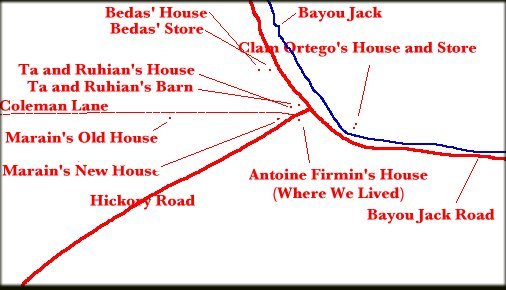
Map of Bodoc as It Was circa 1945

Map of Bodoc as It Was circa 1945
There you have it--Bodoc of the Old Days. We lived as tenants in the Antoine Firmin house. Antoine Firmin himself lived until 1945. He had lived in the "big house" with my mother and father but some time before 1945 he was living in Ta's house with Ta and Uncle Rushian. He owned much land on our side of Bayou Jack and my father's tenant status was au quare (au quatre), which meant that my grandfather was due one-fourth of the harvest. Le quare of the cotton money meant taking over some greenbacks and putting them, amidst expressions of gratitude, in my grandfather's hands. Since my grandfather was living with Ta and Uncle Rushian, this meant that the corn portion was unloaded into Uncle Rushian's barn. This troubled my older brothers and sisters some, but appeared to trouble my father not at all.
A Note on the Bodoc Tree
Since everything about Bodoc tends toward the magical and the wonderful, it should come as no great surprise that its very name is rooted in wonder. Bodoc is a corruption of bois d’arc, or "bow wood." It is a name given by the early French settlers to the Indian’s favorite material for making bows. The botanical name for bois d’arc is
Maclura pomifera, and there is an entry entitled "Osage Orange" in the 1959 edition of World Book Encyclopedia. The Internet abounds with websites devoted to the Bodoc tree and it figures prominently in numerous sites devoted to horticulture generally. (See the links collected at Jim Bolner's Bodoc Tree Page.)In The Morning Advocate of Friday, January 12, 2001, the following interesting story appeared. Now to gather Bodoc balls and plant the seeds!
One will find the Bodoc described as a kind of thorny shrub or bush which was planted along property boundaries to serve as a kind of living fence. The Bodoc tree of my childhood was a full-grown tree which grew in my Uncle Rushian’s lot near his barn; I speak, of course, of the old barn which was sur la pointe (on the point) in front of his house, and not the new barn which he later built in the lot behind his house. In the fall the tree’s pulpy and pimply round fruit, a little larger than a softball, would fall to the ground and would give us ammunition for limited boyhood warfare. We had no contact with other Bodoc trees and the fact that the remainder of the United States, or at least the South and Southwest, knew of the Bodoc tree was unknown.
I was delighted to discover two Bodoc trees on the campus at LSU (as of 2001 they are still there) near the Indian mounds). They are now old and gnarled and past their productive years.